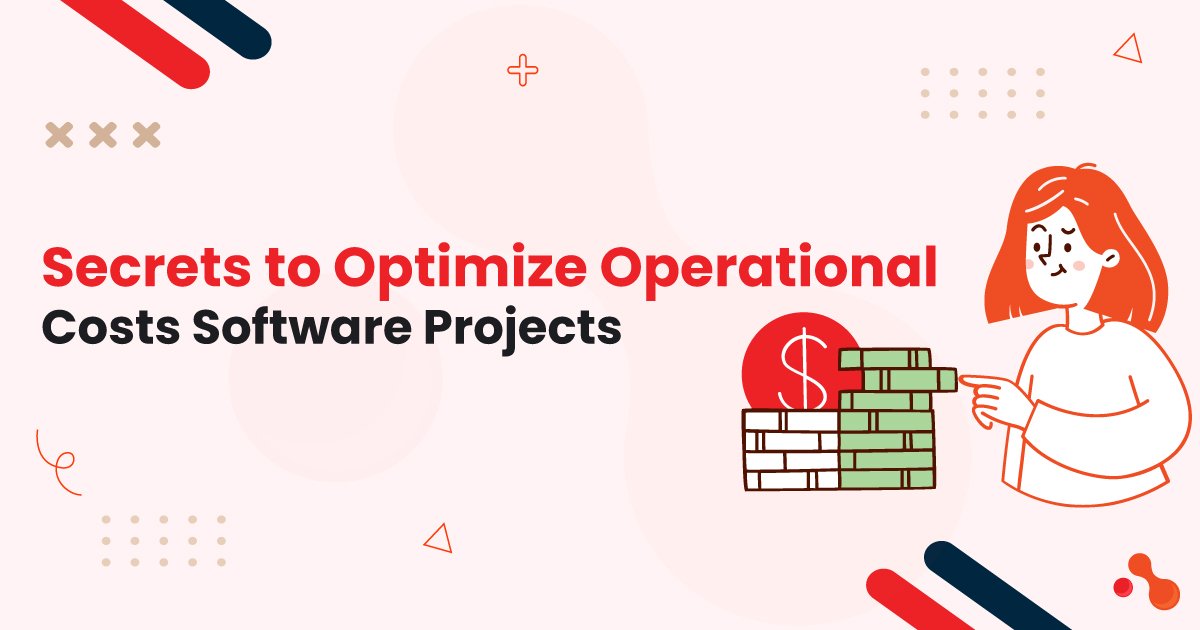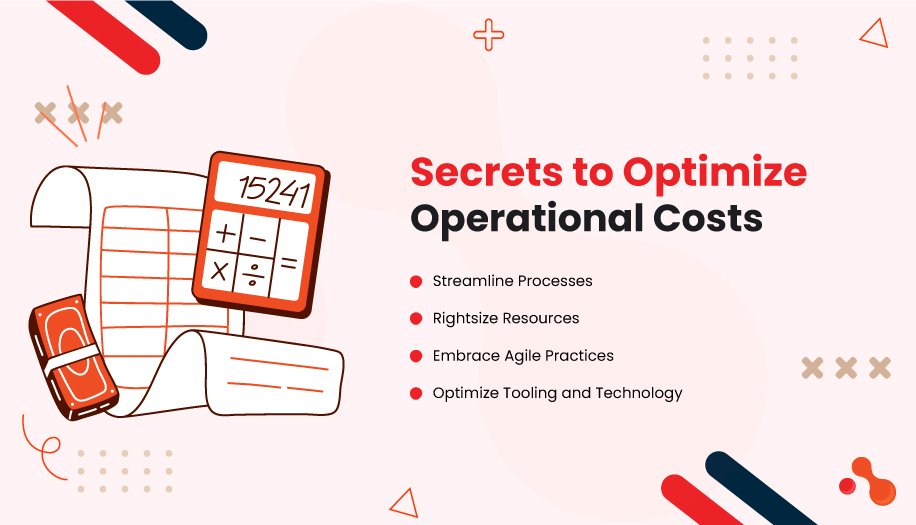18 Secrets to Optimize Operational Costs Software Projects

Optimizing operational costs in a software development project requires a strategic approach. This also requires careful consideration of various factors. This is crucial for the success of any software development project.
It ensures that the project stays within budget and maximizes the return on investment. This article explores various strategies, methodologies, and best practices to optimize operational costs effectively.
It explains how managing these costs effectively can improve resource allocation. This article also helps enhance product quality, and increase competitive advantage.
What is the Operational Cost of Software Development?

Various activities influence operational costs. Several resources are necessary to keep the software development process running smoothly. Operational costs in software development, are often referred to as ‘OpEx’. They encompass all the expenses about the ongoing activities of a software system.
These costs can include server fees, software licenses, maintenance, and support staff salaries. It also includes other recurring expenses necessary to keep the software running smoothly and efficiently. Cost optimization is crucial for maintaining profitability and ensuring the long-term sustainability of software products.
Some common components of operational costs in software development include:
- Salaries, wages, benefits
- Software Licenses and Subscriptions
- Hardware Costs
- Cloud Services
- Utilities
- Office Space Rental
- Communication Expenses
- Training and Professional Development
- Travel and Transportation
- Insurance and Taxes
Our business can benefit in many ways by getting in touch with the professionals at Acquaint Softtech. This includes access to our expertise and experience. We also have good cost reduction skills and do so by identifying potential areas for this purpose.
We have access to the right expertise to implement the best technologies and the right set of tools for this purpose. And also have the ability to come up with the best strategy for your project. Getting in touch with us will ensure continuous improvement with a high level of risk management.
18 Secrets to Optimize Operational Costs

The project of developing software is similar to other types of projects. There are several risks and there is the danger of budget overrun. At times it also includes inappropriate usage of resources that leads to many other issues affecting the entire business.
Optimizing operation costs essentially means adopting a set of processes and practices consistency to improve cost management. Here are the secrets to optimizing operational costs:
Streamline Processes:
Identify and eliminate inefficiencies in development, testing, deployment, and maintenance processes. Streamlining workflows and automating repetitive tasks can help reduce manual effort and operational costs.
Rightsize Resources:
Ensure optimal allocation of resources like personnel, hardware, and software licenses as per project requirements. Avoid over provisioning resources or maintaining excess capacity that leads to unnecessary expenses.
Embrace Agile Practices:
Adopt agile methodologies to promote iterative development, frequent feedback, and continuous improvement. Agile practices help teams respond to changing requirements more effectively, reducing the risk of rework and cost overruns.
Optimize Tooling and Technology:
Evaluate and invest in cost-effective tools and technologies that align with project requirements and budget constraints. Consider open-source alternatives, cloud-based solutions, and pay-as-you-go models to reduce upfront costs and improve scalability.
Focus on Quality Assurance:
Implement robust quality assurance processes to detect and address defects early in the development lifecycle. Investing in quality upfront helps prevent costly rework, maintenance, and support efforts down the line.
Maximize Resource Utilization:
Ensure that resources, such as development teams, infrastructure, and testing environments, are utilized efficiently. Optimize resource scheduling, prioritize high-impact tasks, and minimize idle time to maximize productivity and cost-effectiveness.
Monitor and Analyze Expenses:
Regularly monitor and analyze operational expenses to identify cost-saving opportunities and areas for improvement. Use key performance indicators (KPIs) and financial metrics to track spending, measure performance, and drive informed decision-making.
Promote Cost-Conscious Culture:
Foster a culture of cost-consciousness and accountability within the organization. Encourage employees to identify and implement cost-saving ideas, recognize achievements, and reward cost-conscious behavior.
Optimize Cloud Usage:
Cloud services offer scalable solutions that can be adjusted based on current needs, preventing overpayment for unused resources.
Utilize Open Source Technologies:
Leveraging open-source technologies can significantly reduce software licensing costs. Additionally, open-source solutions often come with robust communities and support.
Implement Continuous Integration/Continuous Deployment (CI/CD):
CI/CD practices allow for early detection of issues, which reduces the cost of fixing bugs and deploying updates.
Regular Review Expenses:
Regularly reviewing and analyzing expenses can help identify areas where costs can be cut without impacting quality.
Align initiatives with business priorities:
Always keep your business priorities in sight. Ensure all your efforts and budget optimization decisions align with them.
Ensure transparency with the right tools:
Incorporate the optimal level of transparency using the right set of tools. This will facilitate the decision making process and optimize every aspect of software development as well.
Prioritize data processing:
AI/ML leads the way when it comes to data processing. Ensure the data is well managed, accurate, and free from issues. This is important because it can influence hypothesis-building and decision-making.
Define a cost structure:
Break the project into smaller sections for cost estimation. This makes it simpler to optimize the cost structure. This is done by identifying the cost and dependencies between the sections and finding the factors that influence the cost.
Implement a robust plan:
Design a top-notch plan after analyzing all the requirements. Be sure to map out everything from the start, which includes the plan, design, development, and testing.
Outsource Non-Core Activities:
Outsourcing tasks that are not core to your business help focus your resources on areas that add the most value. This includes tasks like customer support or data entry. Consider outsourcing non-core activities, such as IT support, infrastructure management, or certain development tasks, to third-party vendors or service providers. Strategic outsourcing can help reduce overhead costs and free up internal resources for strategic initiatives.
Acquaint Softtech is a software development outsourcing company with over 10 years of experience. We have delivered more than 5000 next-generation solutions to clients across the globe. Our professionals have the expertise to optimize the software development process and deliver the project without exceeding the allocated budget or resources.
By applying these secrets to optimize operational costs, organizations can achieve greater efficiency, improve profitability, and enhance the overall success of software development projects.
Seek Help From The Professionals

Hire remote developers from Acquaint Softtech to gain the upper edge. We have the expertise to optimize the software development process. In fact, we have a great deal of experience doing so already.
We have gained exposure to a wide range of industries and worked with clients across the globe. This makes us the ideal firm to outsource your project to. We also provide IT staff augmentation services, which is ideal for businesses with an existing setup wishing to expand or in need of additional resources.
Conclusion
Optimizing operational costs in software development is a multifaceted endeavor that requires a strategic approach. This also demands a commitment to continuous improvement and a culture that values efficiency and innovation.
By understanding and addressing the various components that contribute to operational expenses, organizations can implement targeted efficiency strategies to reduce costs while maintaining or even enhancing the quality and value of their software products. Through careful planning, efficient resource utilization, and the adoption of modern methodologies and technologies, businesses can achieve significant cost savings.
FAQ
What are some key strategies for optimizing operational costs?
Key strategies for optimizing operational costs include streamlining processes, embracing technology, negotiating with vendors, focusing on energy efficiency, optimizing staffing levels, expense monitoring and tracking expenses, outsourcing, and fostering a culture of continuous improvement.
How can technology help in optimizing operational costs?
Technology can help optimize operational costs by automating repetitive tasks, streamlining workflows, improving communication and collaboration, providing data analytics for better decision-making, and reducing manual labor costs.
Why is negotiating with vendors important for cost optimization?
Negotiating with vendors allows businesses to secure better pricing, discounts, or favorable terms, which can lead to significant cost savings in the long run. Effective negotiation skills can help businesses achieve better value for their money and lower overall expenses.
What role does energy efficiency play in operational cost optimization?
Energy efficiency initiatives, such as investing in energy-saving equipment or implementing sustainable practices, can help reduce utility bills and lower environmental impact, leading to long-term cost savings for businesses.
How can outsourcing contribute to operational cost optimization?
Outsourcing non-core functions to specialized service providers can help businesses reduce overhead costs, access specialized expertise, and achieve greater efficiency and flexibility in operations. Strategic outsourcing allows businesses to focus resources on core activities while leveraging external expertise for non-core tasks.



